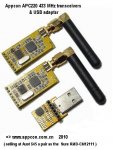The 70 centimetre band is not the only place where small transmitters such as so-called LIPD'S or "low interference potential devices" can be found. An ACA brochure called "Spectrum Opportunities for Short-Range Radio-communications" lists many more.
You'd be amazed at the sorts of applications to which low powered transmitters have been put.
Possibly the most common examples are, remote controlled car alarm systems and garage door openers. These operate near 304, 345 and 433 MHz. Personal and duress alarms, with medical and safety applications operate around similar frequencies as well as above 900 MHz.
Fancy some radio foxhunting? Well, animal tracking devices use 151 and 173.5 MHz. And if you're into tracking whales and/or sharks, you need to go down to the 48 to 49 MHz band for this.
What about locating lost joggers? Lost? We can only assume that they are - why else would anyone go round and round the same block a dozen times if they're not lost? No matter, 77.4 MHz is the place to be for athlete location systems.
What is termed "Auditory assistance" is found near 3 MHz, around 42 MHz, the FM broadcast band, and around 2.4 GHz. These are generally the systems where people put on wireless headphones for spoken information at museum exhibits and the like. The 2.4 GHz segment is also shared with other applications, such as barcode readers. (2010 update -2.4GHz is now heavily used by ZigBee, Bluetooth, WiFi, AV senders, toys, Rc controls & cordless phones etc.
Listening to cordless phones is illegal, yet baby-monitors are not. You can find these around 35 MHz, although we have also heard them near 27 MHz.
Cordless phones, by the way, use a variety of frequencies, such as 1.7/40, 30/39, 915, 1900 and 2400 MHz. Cheap two way radios can be found near 27 MHz, with 55, 152 and 433 MHz also in use.The 40 channel UHF CB ("PRS") band around 476 MHz is however the most popular.
Radio controlled models use a variety of frequencies, such as 27, 29, 36, 41,433 MHz and 2.4GHz. And somewhat bigger models, trains to be exact, use frequencies near 900 MHz for tracking purposes.
Perhaps someone is bugging you? Well, listen for yourself by tuning around 39.5, 88 to 108, 174 to 230, 520 to 820 and 915 to 928 MHz.You'll hear a feedback howl in the receiver if your room is being monitored.
We already know about those pesky crane controllers near 433 MHz and an alternative frequency for them is near 472 MHz. Keeping tabs on crims is easy if you tune to around 314.2 MHz, that's
the "home detention" monitoring device frequency.
Have you ever thought about communicating with your bodily implants? No, well, apparently 262 kHz is the place to try for 'implantable medical devices'.
Biomedical telemetry however also uses various VHF and UHF frequencies including the 70cm LIPD band. We just hope no one is using a 70cm. hand-held in the vicinity!
Moving up, we see the Gigahertz segments used for applications such as distance and speed measurement, cruise control systems, radar fluid measurements and handheld data terminals.
But we've barely scratched the surface. We could go into e-tags, product security tags, computer networks, underground communications, wireless weather stations, video surveillance and more.
It's amazing what has a transmitter or receiver attached to them these days. (ACA website)
(APCNEWS)


